Millet vs Quinoa: Which is Better? A Complete Comparison
Millet and quinoa are both healthy and increasing in popularity. As a Certified Health Coach many people ask me if one is better than the other. Therefore, millet vs quinoa, which is better?
Quinoa is better than millet due to its higher percentage of fiber, B vitamins and minerals. Quinoa is a complete protein meaning it provides all nine essential amino acids, millet does not. Quinoa has a better glycemic index than millet resulting in lower blood sugar levels after consumption.
This article will include a complete comparison between the two including a side-by-side nutrient comparison. In addition, I’ll examine their tastes, textures, prices, glycemic index, satiety index and health benefits.
In addition to coaching clients about them, I’ve purchased, researched and consumed both prior to, during and sometimes after writing this article.
The Difference Between Millet and Quinoa
Many people aren’t familiar with one of the two foods or both. Therefore, a common question asked, what’s the difference?
Quinoa is the seed from a Chenopodium quinoa plant while millet is a seed belonging to the Poaceae family, the grass family. Quinoa is not a grain but it is cooked in water and consumed like a grain. In the U.S. millet is used more for bird seed than human consumption. Quinoa are shaped more oval than the smaller, rounder millet.
Other differences between millet and quinoa:
- Millet, also called proso millet, comes in white, red, yellow and gray colors. Common quinoa colors are white, red and black.
- Millets cost less money.
- Quinoa provides a higher percentage of nutrients, especially protein and fiber.
- Millet is more difficult to find in supermarkets.
- Quinoa has a better glycemic index.
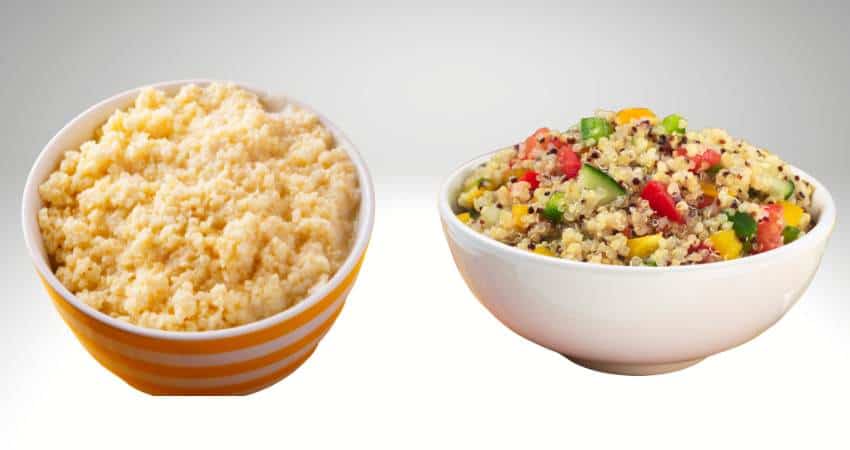
Some similarities:
- They both have a mild taste and may be slightly sweet depending on their color.
- They are both cooked by boiling in water.
- Both have a similar number of calories.
- Both are both gluten free.
Millet vs Quinoa: Nutrient Comparison
Both foods contain many of the same nutrients, although there are key differences between the two. Different varieties of each one may vary slightly in their nutrient content.
The following table is a side-by-side comparison of the nutrients contained in a 100-gram cooked serving.
| Millet (100 g) | Quinoa (100 g) | |
| Calories | 119 | 120 |
| Protein | 3.51 g | 4.40 g |
| Carbohydrates | 23.7 g | 21.3 g |
| Fiber | 1.3 g | 2.8 g |
| Fat | 1.00 g | 1.92 g |
| Sugar | 0.13 g | 0.87 g |
| Vitamin A | 3 IU | 5 IU |
| Beta-carotene | 2 mcg | 0 mcg |
| Vitamin C | 0 mg | 0 mg |
| Vitamin B6 | 0.10 mg | 0.12 mg |
| Vitamin B9 (Folate) | 19 mcg | 42 mcg |
| Vitamin B1 (Thiamin) | 0.10 mg | 0.10 mg |
| Vitamin B2 (Riboflavin) | 0.08 mg | 0.11 mg |
| Vitamin B3 (Niacin) | 1.33 mg | 0.41 mg |
| Vitamin B5 (Pantothenic Acid) | 0.17 mg | 0.33 mg |
| Magnesium | 44 mg | 64 mg |
| Phosphorous | 100 mg | 152 mg |
| Potassium | 62 mg | 172 mg |
| Iron | 0.63 mg | 1.49 mg |
| Copper | 0.25 mg | 0.19 mg |
| Calcium | 16 mg | 17 mg |
| Zinc | 0.91 mg | 1.09 mg |
At first it may be difficult to determine which one provides a higher percentage of nutrients than the other. This causes many people to ask, which one is healthier?
Quinoa is healthier than millet due to its higher percentage of protein, fiber, vitamins and minerals. It provides more B6, folate, riboflavin, B5, magnesium, phosphorus, potassium, iron calcium and zinc than millet. Quinoa has a better glycemic index resulting in less blood sugar levels.
Quinoa is a complete protein meaning it contains all nine of the essential amino acids. Most grain foods, including millet don’t contain all nine amino acids.
Although millet is healthy and does provide a good number of nutrients, just less. It provides a higher percentage of niacin and copper and fewer sugar and total fat. Both foods contain a similar amount of thiamin.
I consume quinoa more often although I include both foods as part of my nutrition plan. I choose it more due to its nutrients, fiber and protein.
Which to Choose
Some people prefer choosing just one, other people may want to alternate between the two for variety.
Some people choose food fitting their particular goals. Let’s examine some of these goals and determine which food is better for them.
Low-carb or Keto Diet
If your goal is a Keto or low-carb diet then carbohydrates may be your number one concern. If you’re on a low-carb diet, you may ask which one has more carbohydrates?
Quinoa contains 11% less carbohydrates per 100 grams cooked than millet making it better for a low-carb diet. Quinoa contains 21.3 grams of carbohydrates per 100 grams cooked.
Another consideration for low-carb diets is the amount of fat and protein. Quinoa provides 1.92 grams of fat and 4.4 grams of protein per 100 grams cooked.
The Doctors in the following video inform you about the health benefits of quinoa, millet and other similar foods.
Weight Loss and Calories
Weight loss may be the most common goal of all. If you want to lose extra pounds from the mid-section, you may ask, which is better for weight loss?
Quinoa is better for weight loss than millet due to its higher percentage of protein, fiber and a better glycemic index. They both have a similar number of calories per serving. Quinoa contains 120 calories per 100 grams cooked. Millet contains 119 calories per 100 grams cooked.
The one calorie difference isn’t large enough to make a difference in total calories consumed.
A better GI, fiber and protein means less blood sugar increases, an increased feeling of fullness and slower digestion. This has been associated in some studies helping weight loss.
Gluten Free
Millet and quinoa are naturally gluten free. In addition, both can be made into flour and used as a substitute for regular flour in gluten free recipes.
My Vitamix blender I use at home can make both flours, almond, cashew or any nut flour in seconds. Check out my blender review here, Vitamix Venturist V1220 Review.
Bodybuilding
If you’re bodybuilding or just have a goal to gain lean muscle mass, there’s a good chance you’re lifting weights at the gym or home. Which one is better for bodybuilding?
Quinoa is better than millet for bodybuilding due to its higher percentage of protein, vitamins and minerals. Quinoa provides 4.40 grams of protein per 100 grams cooked.
It provides 25% more protein than millet. The extra amount of protein, vitamins and minerals help to repair and build new muscle after exercise.
I often eat quinoa during the morning on the days I train at the gym. The carbs help fuel my workout and I’m getting protein at the same time.
Supplements for bodybuilding are expensive, and the costs add up pretty fast. For more details about the prices check out the price section of this article down further.

Taste and Texture
Besides the nutrients, many people choose one food over the other because of its taste. Since there are some similarities between the two, many people wonder and ask, do they taste the same?
Millet and quinoa have a mild flavor. Millet is nuttier than the blander quinoa and both may be sweeter depending on the color. White quinoa and millet are light and fluffy. Red and black are chewier than millet and the white variety.
When quinoa isn’t rinsed or pre rinsed prior to cooking it may taste bitter. The red and black is chewier than the white color.
Millet has an earthy, mild flavor. It is slightly sweet with a hint of nuttiness. It will take on the flavor of ingredients added to the mixture. It has a light and fluffy texture.
To conduct some original research and get the opinions of real people like you, I decided to poll my clients, readers and people in food groups I belong to. I asked them, which one do you prefer the taste of?
- 59% said they preferred the taste of quinoa.
- 33% said they preferred the taste of millet.
- 8% said they had no preference.
To conduct more research I setup and participated in a taste test at home. 75% of us chose the quinoa as the better taste.
Cooking Differences
How to Cook Millet
- Bring 2 cups of water to a boil in a small pot.
- Add 1 cup and salt to taste. Return to a boil.
- Reduce heat to a simmer, cover and cook until tender. About 20 minutes.
- Drain off any remaining water and serve.
How to Cook for Quinoa Recipes
Most store bought is pre-rinsed, if it is not pre-rinsed it should be rinsed to avoid a bitter taste in quinoa recipes.
- In a pot combine 1 cup with 2 cups of water or broth.
- Bring to a rolling boil.
- Reduce heat, cover and simmer until liquid is evaporated (about 10-15 minutes).
- Let stand 5 minutes then fluff with a fork and serve.
- Salt or add spices to taste.
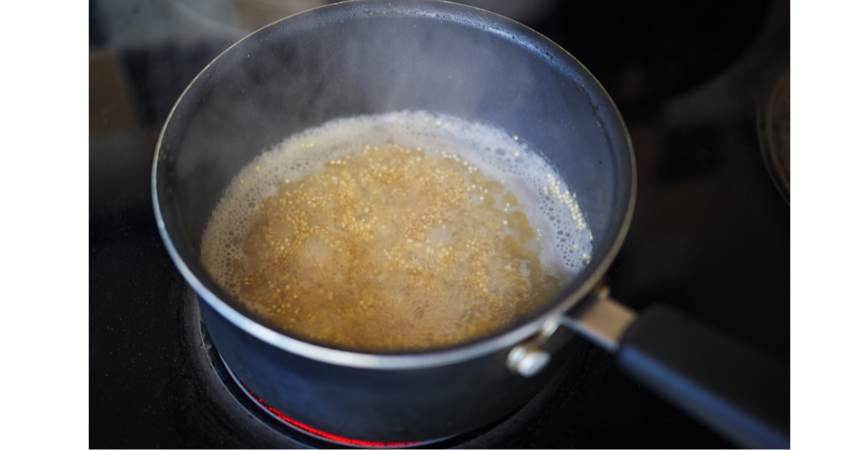
Cooking tips:
- The red color takes about 3-5 minutes longer to cook.
- It’s done when the liquid is absorbed.
- If it’s properly cooked, you can see little, curled ends.
- 1 cup of dry makes about 3 1/2 to 4 cups cooked.
- It should be cooked and not eaten raw.
- For finicky kids, consider adding small amounts to cookies, salads, meatballs or even macaroni and cheese.
Check out 13 healthy substitutes in my article, Quinoa Replacements: 13 Healthy Substitutes.
Substitutions
When someone can’t find one of the two foods called for in a recipe, a common question asked is, can I substitute one for the other?
Millet can substitute for quinoa and both are interchangeable with each other in recipes, side dishes, salads and baking. Both can substitute in gluten free dishes as they are naturally gluten free. When substituting use equal amounts called for in the recipe.
The best substitutes for quinoa are:
- Rice
- Millet
- Barley
- Couscous
- Bulgur
- Lentils
- Amaranth
- Buckwheat
The best substitutes for millet are:
- Quinoa
- Barley
- Rice
- Bulgur
- Lentils
- Couscous
- Buckwheat
- Amaranth
Find out how lentils compared in my article and if they are better.
The video below informs you how to prepare a millet salad.
Glycemic Index and Diabetes
Avoiding blood sugar spikes is an important part of consuming healthy food. This is true for diabetics or anyone worrying about their health3. For this reason, the glycemic index of food is important.
The Glycemic Index (GI) is a scale measuring how fast a particular food raises the blood sugar in the blood. Blood sugar spikes can lead to health complications with the heart, nerves, kidneys and eyes4.
Foods on the GI scale are categorized as:
- Low-GI foods: 55 or under
- Medium-GI foods: 56-69
- High-GI foods: 70 or over
How blood sugars levels are affected:
- Foods with a glycemic index 70 or more cause a quicker spike in blood sugar levels.
- Foods with a glycemic index 56 to 69 cause a moderate spike in blood sugar levels.
- Foods with a glycemic index 55 or less cause a slow spike in blood sugar levels.
Knowing more about the glycemic index of food and how it raises blood sugar, many people ask, which food has a better glycemic index?
Quinoa has a better glycemic index than millet making it more desirable for diabetics. Quinoa is a low GI food while millet is a medium GI food.
- The glycemic index for millet ranges from 54 to 68 depending on the type of millet.
- Red and white quinoa cooked in boiling water for 15 minutes has a glycemic index of 54 and 50.
Find out how these two quinoa varieties compared to each other in my article.
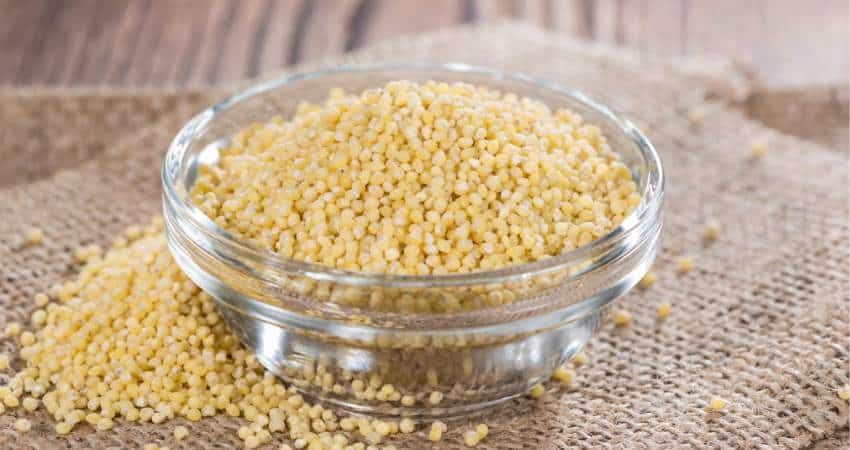
Satiety Index
Satiety is a term used to explain the feeling of being full and the loss of appetite which occurs after eating food. The satiety index is a scale showing how full a person feels after eating a certain food.
The satiety index was developed in 1995 from a study which tested 38 foods. The foods were ranked how they satisfied a person’s hunger. Foods scoring under 100 are considered less filling and foods scoring above 100 are considered more filling ((National Center for Biotechnology Information: A satiety index of common foods)).
The table below shows the satiety scores of oats, lentils, rice and a few other filling foods.
| Food | Satiety Index Score |
| White bread | 100% |
| Brown rice | 132% |
| White rice | 138% |
| Lentils | 133% |
| Wholemeal Bread | 157% |
| Brown pasta | 188% |
| Oatmeal w/milk | 209% |
Unfortunately, either food was not one of the 38 foods tested. A study in 2005, by the University of Milan, tested the satiety of quinoa, oats and buckwheat compared to eating rice. All three had a higher satiating efficiency than rice5.
A study published in 2021 compared the satiety and glycemic response of millet couscous, pasta, potatoes and white rice. The millet based food had a significantly higher glycemic response, lower hunger ratings and higher fullness ratings than white rice6.
Since rice has satiety scores of 132% and 138%, we may be able to assume millet and quinoa has a higher satiety score than 138%.
High satiety foods are likely to have a high satiety score for the following reasons:
- High in protein.
- High in fiber.
- High in volume (foods containing a lot of water or air).
- Low in energy density (foods low in calories for their weight).
Find out how these two quinoa types compared in my article.
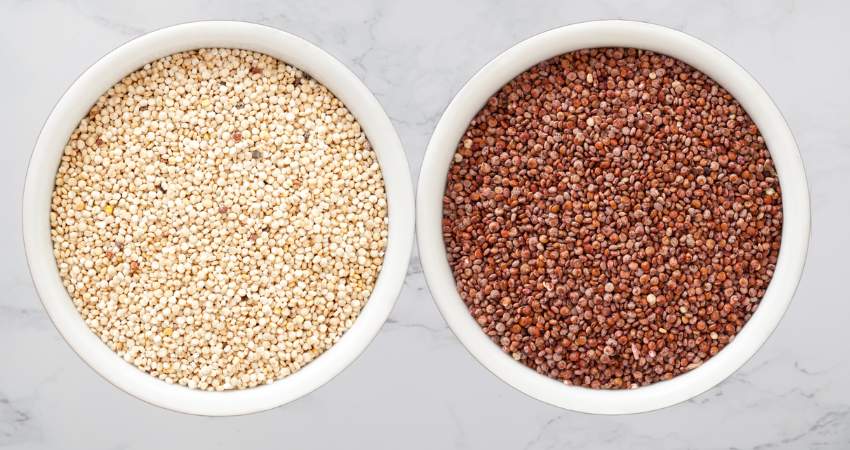
Price
It seems every supermarket visit results in a higher price at checkout than the last time. Unless you hit the lottery, the cost of food certainly matters to most, especially with the rising costs of everything.
Therefore, the price may sway your decision about which one to use in your meals more often. Let’s examine, which one costs more?
Quinoa costs 170% more per 1/4 cup than millet. The average price for quinoa is $0.57 per 1/4 cup. The average millet’s price is $0.21 per 1/4 cup.
The prices for both foods vary depending on the store, location and sales offered. Therefore, to conduct original research, I searched various different stores to compare the price of both foods.
There didn’t seem to be a difference in price between white or tri-color in every store I checked. The red and black types cost more than the white.
I first visited the Shoprite supermarket:
- Wholesome Pantry White Quinoa
- $3.99 per 12 oz bag (7 servings) equaling $0.57 per 1/4 cup serving.
- Wholesome Pantry Tri-Color (White, Red, Black)
- $3.99 per 12 oz bag (7 servings) equaling $0.57 per 1/4 cup serving.
- Bob’s Red Mill Millet
- $3.79 per 28 oz bag (18 servings) equaling $0.21 per 1/4 cup serving.
I then checked Walmart:
- Food to Live White Quinoa
- $10.99 per 1 pound bag
- Food to Live Organic Red Quinoa
- $13.48 per 1 pound bag
- Food to Live organic millet
- $12.99 per 1 pound bag
Health Benefits of Millet and Quinoa
The nutrients in both are similar just in different percentages. Therefore, the benefits contained in both are similar. The following describes how each nutrient may benefit health and which food provides the greater percentage.
In the following video a Doctor informs you about quinoa and its health benefits.
Minerals
Quinoa has a higher percentage of minerals than millet. Let’s take a closer look at some of these minerals and how they benefit health.
Potassium
Potassium helps the body get rid of excess sodium reducing fluid build-up. These help keep systolic and diastolic blood pressure lower ((American Heart Association: How Potassium Can Help Control High Blood Pressure)).
Some medical experts recommend the potassium to sodium ratio of 4:1. Consuming too much sodium or not enough potassium throws off the delicate balance the kidneys need to remove the excess water7.
According to Harvard Health, a number of studies have shown a connection between low potassium levels and high blood pressure8. The more potassium, the more sodium your body will lose.
Magnesium
Magnesium helps keep blood pressure levels stable and balanced. Recent scientific research examined previous studies and concluded magnesium supplementation decreased systolic and diastolic blood pressure9.
Magnesium helps control the following:
- Insomnia
- Blood pressure
- Blood sugar
- Nerve function
- Muscle
In the heart and muscles, magnesium competes with calcium to help the muscles relax after contracting. When the body is low in magnesium, calcium can over stimulate the heart muscle’s cells causing a rapid or irregular heartbeat10.
One reason many people supplement with magnesium in the evening is because it helps calm the whole body including blood vessels.
Calcium
Calcium is important for the heart and blood pressure. Harvard Health reports calcium helps maintain blood pressure by helping in the controlling of the relaxing and tightening of blood vessels11.
Calcium also helps the following:
- Help the muscles to function properly.
- Helps nerve function.
- Maintain and build strong bones.
Phosphorus
Phosphorus has been shown in scientific studies to help with the following:
- Muscle recovery and contraction.
- Promote healthy nerve conduction.
- Promote bone and teeth strength.
- Help the kidneys remove waste.
- Help the body manage and store energy.
Iron
Iron is essential in the creation of red blood cells and is a necessary part of any healthy diet. Iron is also vital for growth and development, as some hormones need iron to be appropriately balanced12.
Find out how bulgur compared in my article. Is it better?
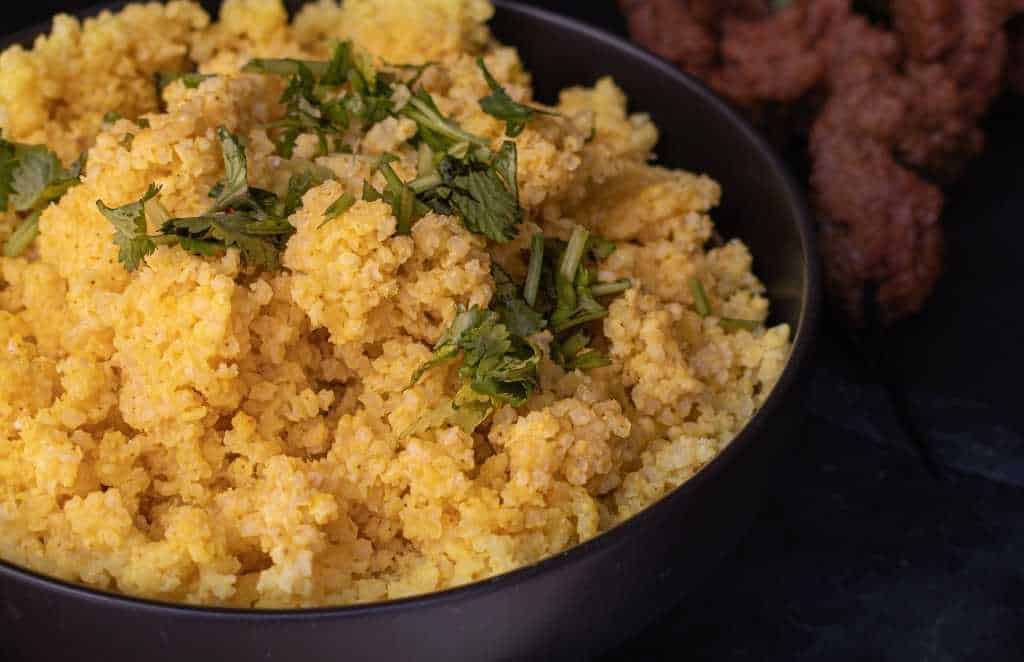
Vitamins
B Vitamins
Quinoa provides a higher percentage of four of the six B vitamins listed below. The B vitamins provided include the following:
- B1 (thiamin)
- B2 (riboflavin)
- B3 (niacin)
- B5
- B6
- B9 (folate)
B vitamins help support the following:
- Brain function.
- Red blood cells.
- Digestion.
- Nerve function.
- Cardiovascular disease.
- Energy levels.
A lack of B vitamins has been associated with oxidative stress and neural inflammation.
In a study released in 2018 32 healthy adults were given B vitamin supplementation for six months. The results indicated preliminary evidence B vitamin supplementation reduced oxidative stress and inflammation13.
Find out how barley compared in my article and if they contain more nutrients.
Macros & Fiber
Fiber
Soluble fiber is helpful for many reasons ((National Center for Biotechnology Information: Mechanisms linking dietary fiber, gut microbiota and colon cancer prevention)). What makes fiber soluble is it dissolves in water.
Soluble fiber is known for the following:
- Help overall digestive health.
- Manage the blood glucose levels which helps decrease the risk of diabetes.
- Helps avoid constipation and have a more regular stool.
- Aids greatly in weight management because it allows you to feel full faster and eat less.
Protein
Both foods are a good source of protein. Protein may help benefit the following:
- Reduce appetite
- Build and repair muscle
- Boost metabolism
- Weight loss
Let’s take a look at their ammonia acid profiles. As noted earlier in the nutrition section of the article, quinoa is a complete protein and contains all the essential amino acids.
If you have any questions about this article don’t hesitate to email us. You can find an email on our contact page.
Read Next – More Quinoa Articles!
Brown Rice vs Quinoa: Which is Better? A Complete Comparison
Couscous vs Quinoa: Which is Better? A Complete Comparison
Quinoa Vs Oatmeal: Which is Better? Let’s Compare
Organic Lentils vs. Conventional Lentils: Which is Better?
Brown Rice vs White Rice: Which is Better for Bodybuilding?
- USDA: Millet, cooked [↩]
- USDA: Quinoa, cooked [↩]
- The University of Sydney: Your GI Shopping Guide [↩]
- National Institute of Diabetes and Digestive and Kidney Diseases: Know Your Blood Sugar Numbers: Use Them to Manage Your Diabetes [↩]
- Pub Med: Effect on appetite control of minor cereal and pseudo cereal products [↩]
- National Center for Biotechnology Information: Some pearl millet-based foods promote satiety or reduce glycemic response in a crossover trial [↩]
- National Center for Biotechnology Information: The Effect of the Sodium to Potassium Ratio on Hypertension Prevalence: A Propensity Score Matching Approach [↩]
- Harvard Health: Potassium lowers blood pressure [↩]
- National Center for Biotechnology Information: Effect of magnesium supplementation on blood pressure: a meta-analysis [↩]
- National Institutes of Health: Magnesium [↩]
- Harvard Health: Key minerals to help control blood pressure [↩]
- National Institutes of Health: Iron [↩]
- National Center for Biotechnology Information: The Effect of a High-Dose Vitamin B Multivitamin Supplement on the Relationship between Brain Metabolism and Blood Biomarkers of Oxidative Stress: A Randomized Control Trial [↩]
